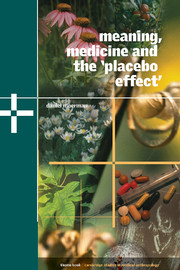Book contents
- Frontmatter
- Contents
- List of figures
- List of tables
- Acknowledgements
- Introduction: “Pickle ash” and “high blood”
- Part I The meaning response
- Part II Applications, challenges, and opportunities
- 7 Psychotherapy: placebo effect or meaning response?
- 8 The neurobiology and cultural biology of pain
- 9 “More research is needed”: The cases of “adherence” and “self-reported health”
- 10 Other approaches: learning, expecting, and conditioning
- 11 Ethics, placebos, and meaning
- Part III Meaning and human biology
- References
- Index
8 - The neurobiology and cultural biology of pain
Published online by Cambridge University Press: 05 June 2012
- Frontmatter
- Contents
- List of figures
- List of tables
- Acknowledgements
- Introduction: “Pickle ash” and “high blood”
- Part I The meaning response
- Part II Applications, challenges, and opportunities
- 7 Psychotherapy: placebo effect or meaning response?
- 8 The neurobiology and cultural biology of pain
- 9 “More research is needed”: The cases of “adherence” and “self-reported health”
- 10 Other approaches: learning, expecting, and conditioning
- 11 Ethics, placebos, and meaning
- Part III Meaning and human biology
- References
- Index
Summary
Telling stories about our lives, or creating meaning from grief, can affect our bodies, our biology. Such meaning responses can occur within a broad range of medical or health phenomena: heart disease, ulcer disease, immune diseases, and so on. But the best-known biological system which displays impressive meaning responses is the body's pain system. This chapter will review the neurobiology and the cultural biology of the human pain system and show how meaning can influence the experience of pain.
Neurology of pain
Pain is an extremely important biological process, a powerful signal an organism uses to signal to itself that “something is wrong.” To lack a sense of pain is to open yourself up to injury which, unrecognized, could easily be fatal. Pain is a primary device for learning. Unfortunately, the pain system can occasionally go awry, causing more trouble than it resolves. In this brief review we will touch only the high points, but you should gain some sense of the value, and the problems, of pain.
Some time ago, Dr. Alan Leslie summarized the case of a very sick man.
I am thinking of a sixty year old man with a cardiac aneurysm [a bulge in one of the walls of the heart] which developed following a coronary occlusion [heart attack]. After some years of auricular fibrillation [irregular heartbeat] and bare maintenance of compensation at absolute rest this man had an aortic saddle embolization [blockage of the arteries to the lungs] which led to gangrene and required amputation of first one then the other leg. During active treatment he received narcotics for which placebo injections were later substituted. […]
- Type
- Chapter
- Information
- Meaning, Medicine and the 'Placebo Effect' , pp. 100 - 115Publisher: Cambridge University PressPrint publication year: 2002
- 1
- Cited by

